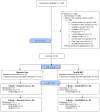A Multicomponent Intervention Including Texting to Promote Tobacco Abstinence in Emergency Department Smokers: A Pilot Study
- PMID: 27146116
- PMCID: PMC4938754
- DOI: 10.1111/acem.12990
A Multicomponent Intervention Including Texting to Promote Tobacco Abstinence in Emergency Department Smokers: A Pilot Study
Abstract
Background: Emergency department (ED) patients commonly smoke. Current treatment approaches use motivational interviewing, which is effective, but resource-intensive. Mobile health approaches may be more feasible and generalizable.
Objective: The objective was to assess the feasibility of an ED-initiated program of tobacco dependence treatment that employs text messaging.
Methods: Smokers age 18 or older were randomized to intervention or control arms. Control subjects received a brochure describing the state smokers' quitline. Intervention subjects received the brochure, 4 weeks of nicotine patches and gum (with the initial dose administered in the ED), a referral to the quitline, and enrollment in SmokefreeTXT, a free SMS-messaging service. SmokefreeTXT delivered 28 days of messages, two to five messages/day. Some messages ask subjects to provide data on mood or craving. Follow-up was conducted by phone call.
Results: Sixty subjects were enrolled in May 2014. Of all subjects, 33 (55%) were nonwhite; 78% were insured by Medicaid. All intervention subjects used the texting program, with 24/30 (80%) using the program for all 28 days. At 1 month, 14/30 subjects (47%) in the intervention arm reported abstinence versus 3/30 (10%) in the control arm (p = 0.003). At 3 months, the abstinence rates in the intervention and control arms were, respectively, 9/30 (30%) and 4/30 (13%; p = 0.21). Subjects responding to more assessments of mood or craving were more likely to report abstinence at 1 month.
Conclusion: A texting program, combined with pharmacotherapy and a quitline referral, is feasible and may promote tobacco abstinence in ED smokers. A larger trial is planned to assess these results.
© 2016 by the Society for Academic Emergency Medicine.
Figures
References
-
- Stead LF, Koilpillai P, Lancaster T. Additional behavioural support as an adjunct to pharmacotherapy for smoking cessation. Cochrane Database of Systematic Reviews. 2015 - PubMed
-
- Fiore MC, Jaén CR, Baker TB, et al. Treating Tobacco Use and Dependence: 2008 Update. Rockville, MD: US Department of Health and Human Services; 2008.
Publication types
MeSH terms
Grants and funding
LinkOut - more resources
Full Text Sources
Other Literature Sources
Medical
Miscellaneous



